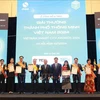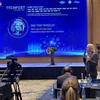The wind-power plant in the Mekong Delta province of Bac Lieu, which is among the largest ones in Southeast Asia, joined the national power grid on May 29. It opens up a great opportunity to develop wind electricity in both regional and national scale.
2012 is considered as an eventful year in the development of wind electricity with 10 giant turbines installed in Bac Lieu sea and dozens of other projects planned across the country, particularly in the Mekong Delta region.
The construction of the plant, which is bigger than the one in central Binh Thuan province, began on September 9, 2010. The project covers 50 hectares of alluvial land with a total investment of 4.5 trillion VND (214 million USD). It includes 62 wind turbines and has a capacity of 99MW, generating 400 million kWh per year. And its 10th turbine was successfully installed on October 2, 2012.
Particularly, the wind turbines are installed in coastal swamp areas where do not contain production land, thus local residents are almost not affected by the project.
The project’s initial success offers a direction of developing wind electricity for investors and local authorities. In the Mekong Delta region alone, dozens of wind-power projects have been planned at present.
Following this plant’s success, Bac Lieu province has been allowed by the Government to expand its project to 10 wind turbines.
In the southern province of Soc Trang, four wind-power plants are expected to be built in Vinh Chau and Tran De districts with a total capacity of 300MW. Investment in a 200MW wind-power plant in Can Gio district, Ho Chi Minh City, is also being promoted.
In October 2011, the US Export - Import Bank pledged to give a one billion USD loan to Vietnam to develop wind electricity in Mekong Delta provinces from 2011 to 2015.
Vesta, the largest wind turbine manufacturer in the world, signed an agreement on planning and developing wind-power plants in Vietnam with the Cong Ly Construction-Trade-Tourism Company – investor of the Bac Lieu power plant – on November, 2012.
Earlier, on September 26, 2011, the Government issued preferential policies on investment in wind electricity (under the Decision No. 37/2011/QD-TTg), with a number of content which facilitate the development of wind electricity in both local and national scales.
According to General Director of the Cong Ly Company To Hoai Dan, the World Bank conducted a detailed survey of wind energy in Southeast Asia . And Vietnam has the greatest potential of wind energy among four surveyed countries, namely Thailand, Laos, Cambodia and Vietnam.
Up to 8.6 percent of Vietnam’s territory is rated to be good or very good for building large wind turbines, compared to 0.2 percent in Cambodia, 2.9 percent in Laos and 0.2 percent in Thailand.
The total potential of Vietnam’s wind electricity is estimated at 513,360 MW, over 200 times more than the Son La Hydropower Plant’s current capacity.
Forty one percent of rural area in the country is favourable to build small wind turbines to serve the economic development, whereas only 6 percent of that in Cambodia, 13 percent in Laos and 9 percent in Thailand is.
“Now we can affirm that wind energy is an enormous potential of Vietnam in general and of the Mekong Delta region in particular. And there are now all favourable conditions to exploit it”, said To Hoai Dan.-VNA
2012 is considered as an eventful year in the development of wind electricity with 10 giant turbines installed in Bac Lieu sea and dozens of other projects planned across the country, particularly in the Mekong Delta region.
The construction of the plant, which is bigger than the one in central Binh Thuan province, began on September 9, 2010. The project covers 50 hectares of alluvial land with a total investment of 4.5 trillion VND (214 million USD). It includes 62 wind turbines and has a capacity of 99MW, generating 400 million kWh per year. And its 10th turbine was successfully installed on October 2, 2012.
Particularly, the wind turbines are installed in coastal swamp areas where do not contain production land, thus local residents are almost not affected by the project.
The project’s initial success offers a direction of developing wind electricity for investors and local authorities. In the Mekong Delta region alone, dozens of wind-power projects have been planned at present.
Following this plant’s success, Bac Lieu province has been allowed by the Government to expand its project to 10 wind turbines.
In the southern province of Soc Trang, four wind-power plants are expected to be built in Vinh Chau and Tran De districts with a total capacity of 300MW. Investment in a 200MW wind-power plant in Can Gio district, Ho Chi Minh City, is also being promoted.
In October 2011, the US Export - Import Bank pledged to give a one billion USD loan to Vietnam to develop wind electricity in Mekong Delta provinces from 2011 to 2015.
Vesta, the largest wind turbine manufacturer in the world, signed an agreement on planning and developing wind-power plants in Vietnam with the Cong Ly Construction-Trade-Tourism Company – investor of the Bac Lieu power plant – on November, 2012.
Earlier, on September 26, 2011, the Government issued preferential policies on investment in wind electricity (under the Decision No. 37/2011/QD-TTg), with a number of content which facilitate the development of wind electricity in both local and national scales.
According to General Director of the Cong Ly Company To Hoai Dan, the World Bank conducted a detailed survey of wind energy in Southeast Asia . And Vietnam has the greatest potential of wind energy among four surveyed countries, namely Thailand, Laos, Cambodia and Vietnam.
Up to 8.6 percent of Vietnam’s territory is rated to be good or very good for building large wind turbines, compared to 0.2 percent in Cambodia, 2.9 percent in Laos and 0.2 percent in Thailand.
The total potential of Vietnam’s wind electricity is estimated at 513,360 MW, over 200 times more than the Son La Hydropower Plant’s current capacity.
Forty one percent of rural area in the country is favourable to build small wind turbines to serve the economic development, whereas only 6 percent of that in Cambodia, 13 percent in Laos and 9 percent in Thailand is.
“Now we can affirm that wind energy is an enormous potential of Vietnam in general and of the Mekong Delta region in particular. And there are now all favourable conditions to exploit it”, said To Hoai Dan.-VNA



















